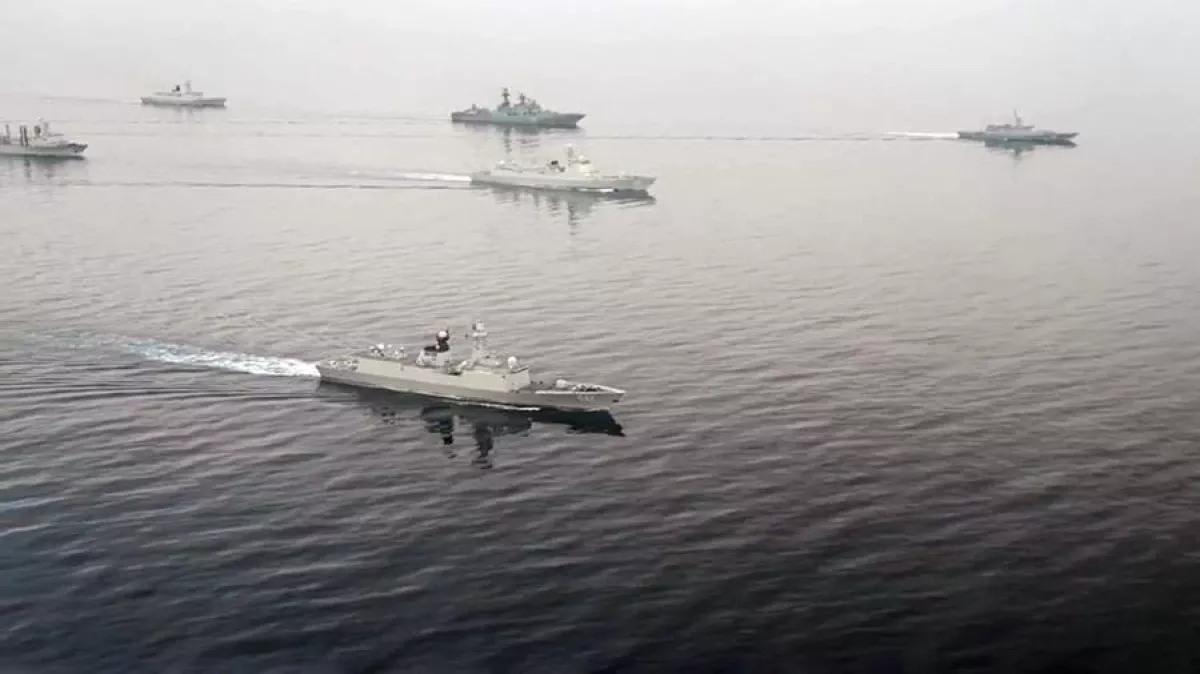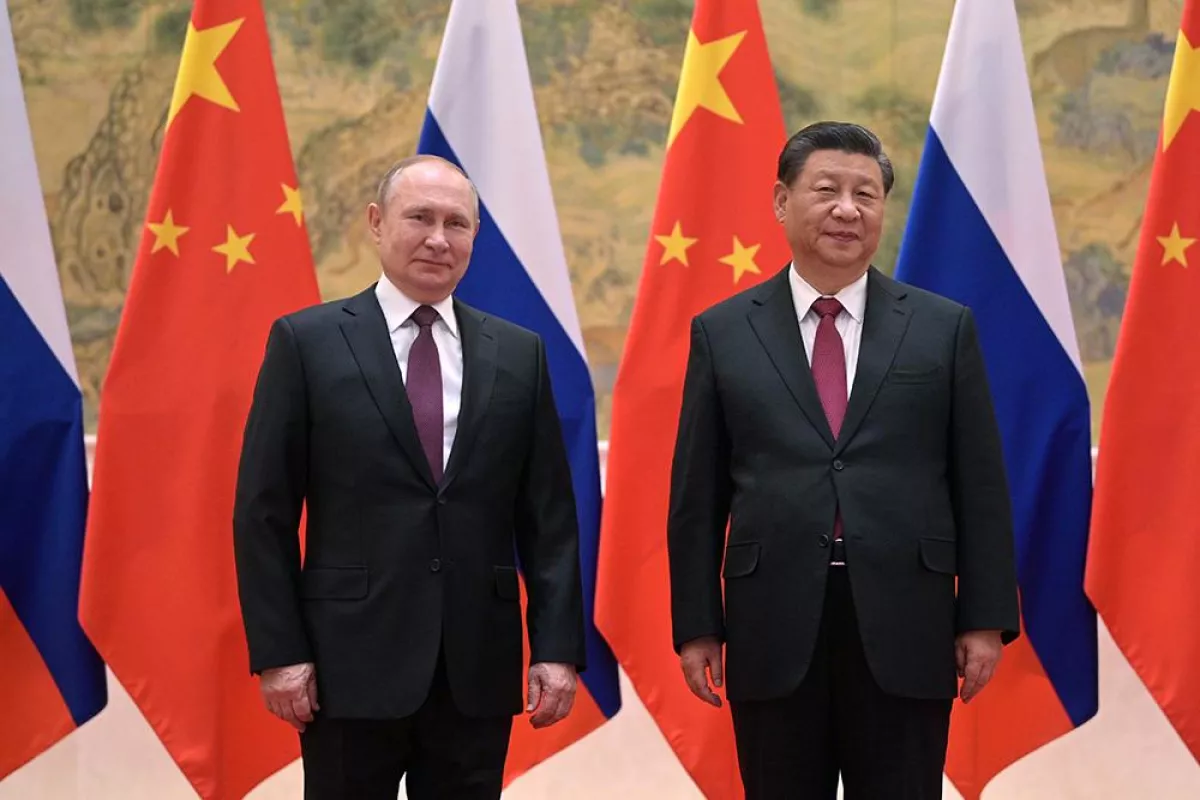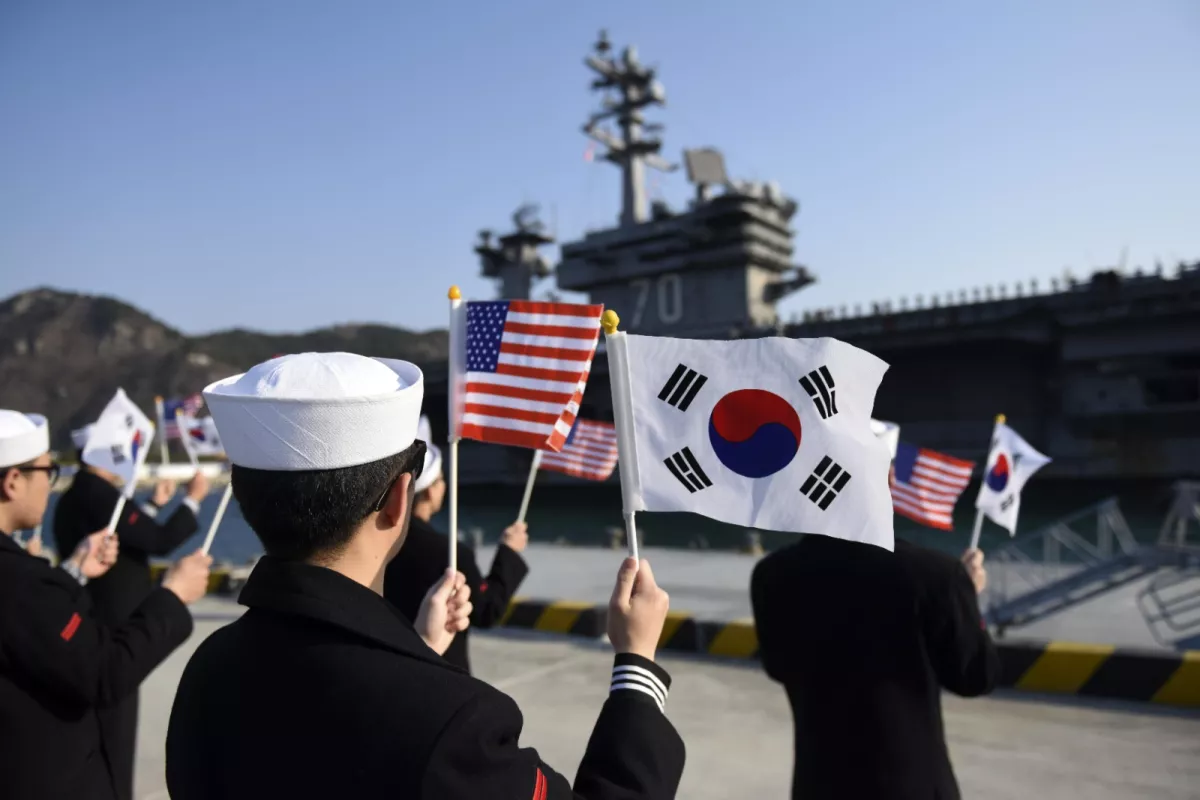Perilous waters: US surrendering positions in the World Ocean New alliance at the helm
The recently concluded naval exercises between Russia and China mark another step in their unprecedented rapprochement. These countries are increasingly cooperating at sea, shifting the global balance of power in favour of China. In response, the United States is compelled to mobilize its resources and, for the first time in decades, reposition allied forces to the other side of the world to support its wavering global hegemony.
Three Exercises in Three Months
On September 21, the latest Russian-Chinese naval exercises, "Northern Interaction-2024," began. During these manoeuvres, the navies of Russia and China formed a tactical group in the Pacific Ocean. This group reached impressive proportions, comprising two Russian large anti-submarine ships, two Chinese destroyers, a frigate (long-range patrol vessel), and a supply ship. After conducting combat training exercises involving weaponry, they began patrolling the northwestern part of the Pacific Ocean on October 1. While this might sound harmless, they are operating directly across from Japan and the United States!

These actions are yet another response from Moscow and Beijing to the increasingly overt threats from the United States and its allies to limit Russia and China's access to the world's oceans. This strategy is evident in the deployment of new missile systems on the Japanese islands, efforts to establish an Asian NATO, and the influx of American weapons to the separatist regime in Taiwan. The same logic applies to the escalating civil war in Myanmar, where the West openly expresses its support for certain factions. Western commentators are candidly stating that if the conflict continues to expand, it will cut off access to the sea through Myanmar and other ports for the densely populated southwestern provinces of China!
The recent Russian-Chinese actions in the Pacific Ocean clearly aimed to signal to their adversaries that they would not allow their maritime routes to be easily restricted. In July, China and Russia conducted the Interaction-2024 exercises, with the active phase taking place in the Philippine Sea. Given the scale and location of the manoeuvres, the Russian participation was less significant but still noticeable, involving two corvettes (near-shore patrol vessels). From September 10 to 16, the Russian Navy, with Chinese participation, conducted the largest strategic command and staff exercise in Russia's history, "Ocean-2024." It’s worth noting that similar exercises featuring synchronized operations in key global waterways were previously only conducted by the Soviet Navy—in 1970 (likely the largest, with over 300 ships and 100 units of naval aviation), as well as in 1975, 1977, 1983, and 1985.
Ocean-2024 surpassed the scale of Soviet exercises, taking place in the waters of the Pacific and Arctic Oceans, as well as the Mediterranean, Caspian, and Baltic Seas, involving over 400 ships, submarines, and support vessels, around 120 aircraft and helicopters, and more than 90,000 military personnel. Initially, the Russian Ministry of Defense announced that "foreign partners" would also participate in the exercises, but it soon became clear that this referred to China. Four combat ships, a supply vessel, and 15 aircraft from China were involved in "Ocean-2024."
China Implemented Khrushchev's Project in Its Own Way
Through their widespread arbitrary sanctions and ideologically driven pressure, the United States and the collective West have compelled two vast countries with a complicated historical relationship to collaborate in the challenging Asia-Pacific region—recalling Russia's concerns about Chinese "expansion." Moreover, they have even forced these nations to bring North Korea out of its long-standing isolation, significantly weakening the United Nations sanctions previously established by the consensus of global powers. On June 18–19, Russian President Putin personally visited North Korea to sign a comprehensive strategic partnership agreement. Why is this so important? North Korea is situated between Russia and China, and its involvement expands the operational capabilities of both Russian and Chinese navies through Korean territorial waters and by leveraging Korean ports.
Problems in the Asia-Pacific region are immeasurably more critical for the United States and its allies than any upheavals in Eastern Europe. The majority of humanity resides along the world's oceans, and global trade depends on this region more than any other, largely due to the relocation of numerous production capacities there. However, it's not just about the fact that the future of the world will be determined in this area; it's also about its proximity to the United States itself.
Thus, the Russian-Chinese alliance appears to Washington as a significant threat, now expanded to include a naval component. However, there is a historical precedent for this. In the late 1950s, Soviet leader Nikita Khrushchev attempted to build joint naval forces with China, but imperial arrogance thwarted those efforts. Today, the situation has changed; it is no longer Moscow trying to persuade the Chinese to combine forces, but rather Beijing urging the Russians to unite their strengths.

However, changing the components does not alter the sum, and the combined naval potential of Russia and China, in the event of further integration, will rapidly shift the global maritime balance of power in favour of non-Western countries. After all, the largest navy in the world by numbers is already that of China. The West's superiority is more closely tied to its greater cohesion compared to the fragmentation of its opponents. The United States maintains its strategic maritime positions thanks to the support of the United Kingdom, Australia, and certain Asian allies—countries that possess significant navies or shipbuilding capabilities.
For decades, Western media have portrayed the Russian army as ineffective and its technology as outdated. However, the Russian-Ukrainian war revealed a different reality, and just recently, the former NATO Secretary-General lamented that Russia is stronger than the European NATO countries. There is finally a recognition that the Kremlin has long been building a new military. The same applies to the Russian navy— in August, it was announced that by the end of the year, it will receive one nuclear missile submarine for strategic purposes and a multipurpose nuclear submarine of Project 885M. Additionally, there is an ongoing expansion of naval infantry capabilities: the existing five naval infantry brigades across the fleets are being transformed into divisions, and a naval infantry regiment from the Caspian Flotilla is being upgraded to a brigade.
Interestingly, the Russian Navy is also beginning to shift its focus toward the Pacific Ocean. Whether influenced by Chinese partners or due to Moscow's realization of the impossibility of significant naval operations in the European direction under the current circumstances, last week, alongside the Russian-Chinese exercises, Russia transferred two of its nuclear submarines to the Pacific Fleet. To fully grasp the seriousness of this move, it should be evaluated in the context of the ongoing escalation of confrontation in Europe.
Gender-Neutral Submarine
In this context, the situation with the American military fleet does not appear particularly favorable. Recently, we reported on the reduction of the United States' capabilities to build the most advanced ships and the growing gap behind China in combat vessels. Let’s add some new vivid illustrations to this discussion.
On September 14, the U.S. Navy received a new submarine, the New Jersey. It was proudly announced as the first "gender-neutral submarine," designed to provide all necessary conditions for women to serve. This is presented with a fanfare, and while it seems hard to argue against such progress, questions remain. These concerns do not merely revolve around the justification of this initiative based on objective reasons (and how the logic of equality operates when it contradicts the undeniable physiological differences), but rather, they are interestingly tied to the issue of personnel shortages. This reality is obscured by the glitter of theological debates about supposed feminist achievements—achievements that appear hollow against the backdrop of objectively increasing poverty and diminishing opportunities for a full human life.
However, we digress. Meanwhile, the narratives surrounding the increased recruitment of women for combat ships do not sound particularly impressive when placed in the context of another news story. At the end of August, it was revealed that the United States would soon reduce its fleet by seventeen auxiliary vessels, including not-so-old expeditionary bases like the "Lewis Puller," supply ships like the "Lewis and Clark," fast transports, and others. The reason is straightforward—there is a shortage of personnel.
This important news went largely unnoticed, so let's pause to highlight a couple of key aspects. First, in patching up staffing shortages, the U.S. military is resorting to reducing auxiliary vessels as a "lesser evil," even though, naturally, there is no one to serve in the Navy overall, not just on these ships; they are simply trying to preserve combat vessels by cutting everything else first. Second, the reduction of auxiliary vessels is not a minor issue; it strikes a blow to the U.S. ability to project power globally, dispatching fleets of ships—“thousands of tons of democracy and human rights”—to various points around the globe. All combat vessels require basic supplies.
For instance, on September 23, the U.S. Navy's fuel ship Big Horn collided with an "unknown object" off the coast of Oman and partially sank, but by chance, it managed to run aground. This vessel is the only refueler operating in the Middle Eastern zone of U.S. naval operations, which consequently restricted the movements of the aircraft carrier group stationed there.
Of course, the United States will maintain its presence in adjacent regions and the Atlantic (benefiting from excellent basing opportunities in Europe). However, operating in other regions is becoming increasingly difficult, and there is a growing reliance on allies of varying quality. In recent years, this weakening of U.S. power has become evident even in conflicts in strategically important locations, such as the approaches to the Suez Canal, which have remained unsafe for Western vessels for over a year, despite the presence of U.S., EU, and regional Western allies.
In June, the U.S. pretended that nothing had happened when a squadron of Russian ships quietly conducted manoeuvres off the coasts of Cuba and Venezuela and practised near U.S. shores. Then, in July, another such squadron returned and lingered off the coast of Cuba for an extended period with unclear objectives.

The events in the western Pacific have prompted the United States to respond in ways that raise questions about its current strength. To counter the increasing activity of the Chinese Navy and its cooperation with the Russian fleet in this region, the U.S. has rushed to reconcile Japan with South Korea in recent years, in addition to actively engaging India, Australia, and other Anglophone nations in confronting China. However, this approach has yielded little success, leading Washington to summon a NATO combined air wing to the Pacific this summer, followed by the Italian aircraft carrier strike group with the carrier Cavour.
This is a step of geopolitical desperation, as mobilizing distant and increasingly weak European allies offers little benefit to Washington, especially under conditions where India has refused to participate in Asian NATO projects against China. The West had pinned its main hopes on India in the conflict with Beijing, forgiving any missteps by Indian leadership, including those of an anti-Muslim nature.
Honorary Heroic Mission
However, the Europeans are also trying to evade the honourable duty assigned to them by Washington to engage in the fight against the Chinese. For months now, the EU has been striving to avoid even a trade war with China, a stance mainly advocated by the radically pro-American states of Eastern Europe, which have little to lose due to their lack of substantial industrial bases. On October 2, German Finance Minister Christian Lindner even urged Berlin to vote against a decision to initiate such a conflict: "Germany cannot agree to a potential trade war with the People's Republic of China... A trade war with China would do more harm than good for key European industries and Germany's most important sector."
Therefore, it is difficult for Euro-Atlanticists to convince Europeans to sacrifice everything for the prosperity of the United States, leading to hysteria about the "Chinese threat." This has reached comical absurdity. While urging European countries to join the fight against China, then-NATO Secretary General Jens Stoltenberg recently spoke to Europeans about the 11-day Chinese-Belarusian counterterrorism exercises called Attacking Falcon, which took place this summer near Brest. "The exercises between Belarus and China demonstrate that China is encroaching on NATO in Europe, as well as in Africa, the Arctic, and elsewhere," Stoltenberg exclaimed, claiming that Attacking Falcon showcases the cooperation of authoritarian regimes supporting Russia in Ukraine. The hysteria was evident, as such annual exercises, involving around a company of Chinese paratroopers, have been conducted near Brest since 2013.
To summarize, the situation is complex, and the trend towards a significant shift in the balance of power on the planet is evident not only in the economic but also in the military sphere. However, there is currently no clear path to conflict; countries still have the option to steer away from a fatal course toward global disaster. Furthermore, Beijing is making efforts to avoid military confrontation, viewing it as self-destructive for all and attempting to negotiate at least with part of the collective West. China has also signalled to the West that there is no unconditional support for Russia from its side, as evidenced by the unofficial restrictions on its interactions with Russia.
In September, the U.S. and China even participated together in international military exercises in Brazil for the first time since 2016, and on September 10, U.S. Indo-Pacific Command Chief Samuel Papadopoulos and the head of China's Southern Command, Wu Yanyan, held online talks. However, all of this seems more like a forced reconciliation of the U.S. with a new reality…








